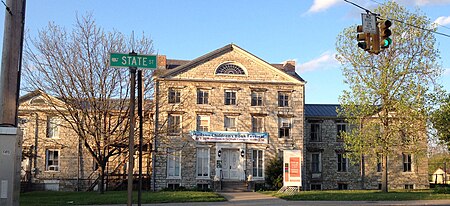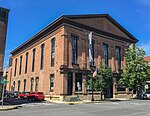Hudson Almshouse
Buildings and structures in Columbia County, New YorkFederal architecture in New York (state)Government buildings completed in 1818Government buildings on the National Register of Historic Places in New York (state)National Register of Historic Places in Columbia County, New York

Hudson Almshouse, also known as the Hudson Lunatic Asylum, Hudson Orphan and Relief Association, and Hudson Area Association Library, is a historic almshouse located at Hudson, Columbia County, New York. It was built about 1818, with a substantial rear addition built between about 1884 and 1889. It consists of a three-story central section with two-story flanking wings constructed of dressed limestone. Originally built as an almshouse, it subsequently served as a mental health asylum, female academy, private home, and from 1959 to 2016, the local association library.It was added to the National Register of Historic Places in 2008.
Excerpt from the Wikipedia article Hudson Almshouse (License: CC BY-SA 3.0, Authors, Images).Hudson Almshouse
State Street,
Geographical coordinates (GPS) Address Phone number Nearby Places Show on map
Geographical coordinates (GPS)
| Latitude | Longitude |
|---|---|
| N 42.2525 ° | E -73.786944444444 ° |
Address
Hudson Area Library
State Street 400
12534
New York, United States
Open on Google Maps






